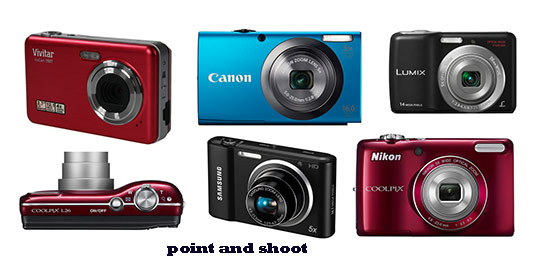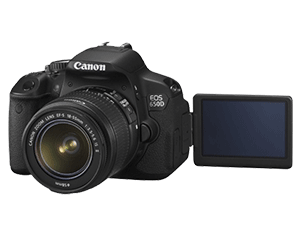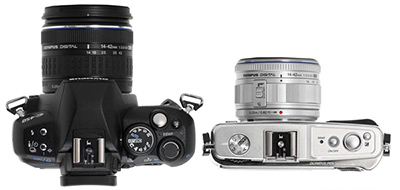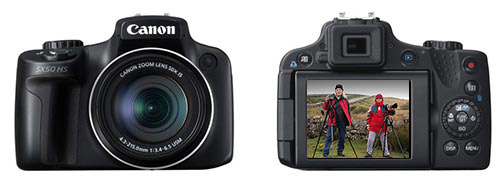Point and shoot compacts
You will find this defined differently depending what you read. We define as ‘point and shoot’ cameras that do that do the basics for you without much intervention on your part. These would be the cheapest compacts that you will find in most supermarkets. The specifications of Compact cameras have improved in two areas in particular in recent years, firstly higher pixels (you can get cheap compacts at 16 megapixels) secondly improved noise performance in low light.
Both these are welcome but don’t’ put much store on the extra megapixels, it is still the sensor size that is the main factor and also the main factor in the price you pay. In addition even cheap compacts now have video, usually at low (not full) HD. Here is an example of the type of compact camera that is point and shoot – they tend to be very thin and have very few settings.
Note that the Nikon bottom left has a large shutter button but no mode dial – this is typical since you are not expected to make the crucial decisions. These cameras will give you fairly good quality when you have very good shooting conditions but in other cases can give you badly exposed or noisy photos since you have little control over them and the variations that camera can make itself are limited. There is some crossover of features – you can’t always tell if a compact described as ‘point and shoot’ has a mode dial or equivalent on a touchscreen. As a rough guide we are not seeing any compact under £80 that has advanced features (i.e. being able to change shutter and aperture yourself).
Point & Shoot Digital Cameras at Amazon
High Quality Compacts
The higher end compacts give you the chance to control your camera more then the point and shots: especially look for shutter and aperture priority modes. Most high end compacts usually give you some control by letting you set minimum shutter speeds or an ISO range if they don’t actually let you change shutter and aperture directly. Example quality Compacts which let you change shutter and aperture directly are Canon G series – now at G16 – Panasonic LX7, TZ40, Nikon P340. These and many other high end compacts are eminently suitable for our Workshops.
High Quality Compacts The higher end compacts give you the chance to control your camera more then the point and shots: especially look for shutter and aperture priority modes. Most high end compacts usually give you some control by letting you set minimum shutter speeds or an ISO range if they don’t actually let you change shutter and aperture directly. Example quality Compacts which let you change shutter and aperture directly are Canon G series – now at G16 – Panasonic LX7, TZ40, Nikon P340. These and many other high end compacts are eminently suitable for our Workshops.
browse a range of high-end compacts at Amazon
DSLR Cameras
Digital SLR cameras have evolved out of the original film SLR cameras. The huge advantage they have over film cameras is that you can see your images in situ instead of waiting for the film to be developed.
This means that you need never have a wrong exposure again (with a bit of work !)
They have the best quality (larger sensors) and lenses, but range from entry level to professional. Prices for the cameras can therefore range from £300 – £6000 and the same goes for the lenses. You get what you pay for and the quality will vary from good to stunning. Canon and Nikon are the leaders in the DSLR market with Sony and Panasonic bringing out very innovative features and good quality. The disadvantage is heavy bulk and weight – especially with additional lenses. As the DSLR cameras get more expensive they get heavier and feel like bricks, but they also give you great confidence. Note: you don’t take better photos by buying the most expensive camera (unless you want to stay on Auto permanently) – as they get more expensive you have to know more and you need to up your skill level. Any DSLR is fine for any of our courses.
Check out a Range of DSLR cameras at Amazon
Compact System Cameras
Previously known as MILC or interchangeable lens compacts – these cameras are now very popular. They offer quality higher than most compacts and also the advantage of lenses you can change just like a DSLR. We have extensive experience of teaching these on our courses.
The sensors in these cameras are smaller then a DSLR so the quality will not be as good (but close to entry level DSLR). If they have a viewfinder they are electronic (like an LCD) rather than optical. The other advantage is that they are significantly smaller than a DSLR, though bigger than a compact – below right is a Compact System Camera – Olympus EP1 – (don’t forget you may also have extra lenses too)
browse a range of Compact System Cameras at Amazon
Note the top dial on the Panasonic LX7 above – this is typically where you see the mode dial and is a quick way of seeing if the camera you are interested in might have advanced features. Look for P and A and S on the dial. These are a good choice if you want lightness in weight but still get good quality that you can view your photos on a tv or moniter screen. They are also a good backup if you already have a DSLR but want something you can carry around all the time. browse a range of high-end compacts DSLR Cameras Digital SLR cameras have evolved out of the original film SLR cameras. The huge advantage they have over film cameras is that you can see your images in situ instead of waiting for the film to be developed.
Bridge Cameras
They look like DSLR or MILC (Compact System) cameras but they are fixed lens and they are significantly cheaper than either. You do not get the high quality, but you may not notice if you only want to view snaps on your computer monitor. You can get 50X lenses as on the Canon SX50 (shown below) which is equivalent to 24 – 1200 mm on a 35mm DSLR – quite a range ! Also of note is the Nikon Coolpix 530.
Since there have been improvements in ISO in the last few years bridge cameras can be very useful for, say, holiday photos where you don’t want too much weight to carry and you want some creative control with a big zoom lens. The drawback with bridge cameras are the smallish sensor and small aperture range (which can limit your creative options) but if you are on holiday in the sunshine and you want to view your photos only on a monitor or TV screen then this could be a good choice for you at a relatively low price. They are a good choice if you want to learn photography quickly on a cheaper camera before upgrading to a DSLR. Don’t expect it to be as good as a DSLR (some people do). We would recommend to get Canon, Panasonic, Nikon or other major make of Bridge camera and not too cheap. Bridge cameras are suitable for all our courses but you would find them limiting on a Masterclass.
browse a range of Bridge Cameras at Amazon
<<Back Equipment Guide Next >> Guide to Lenses





